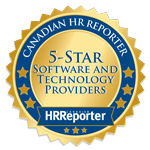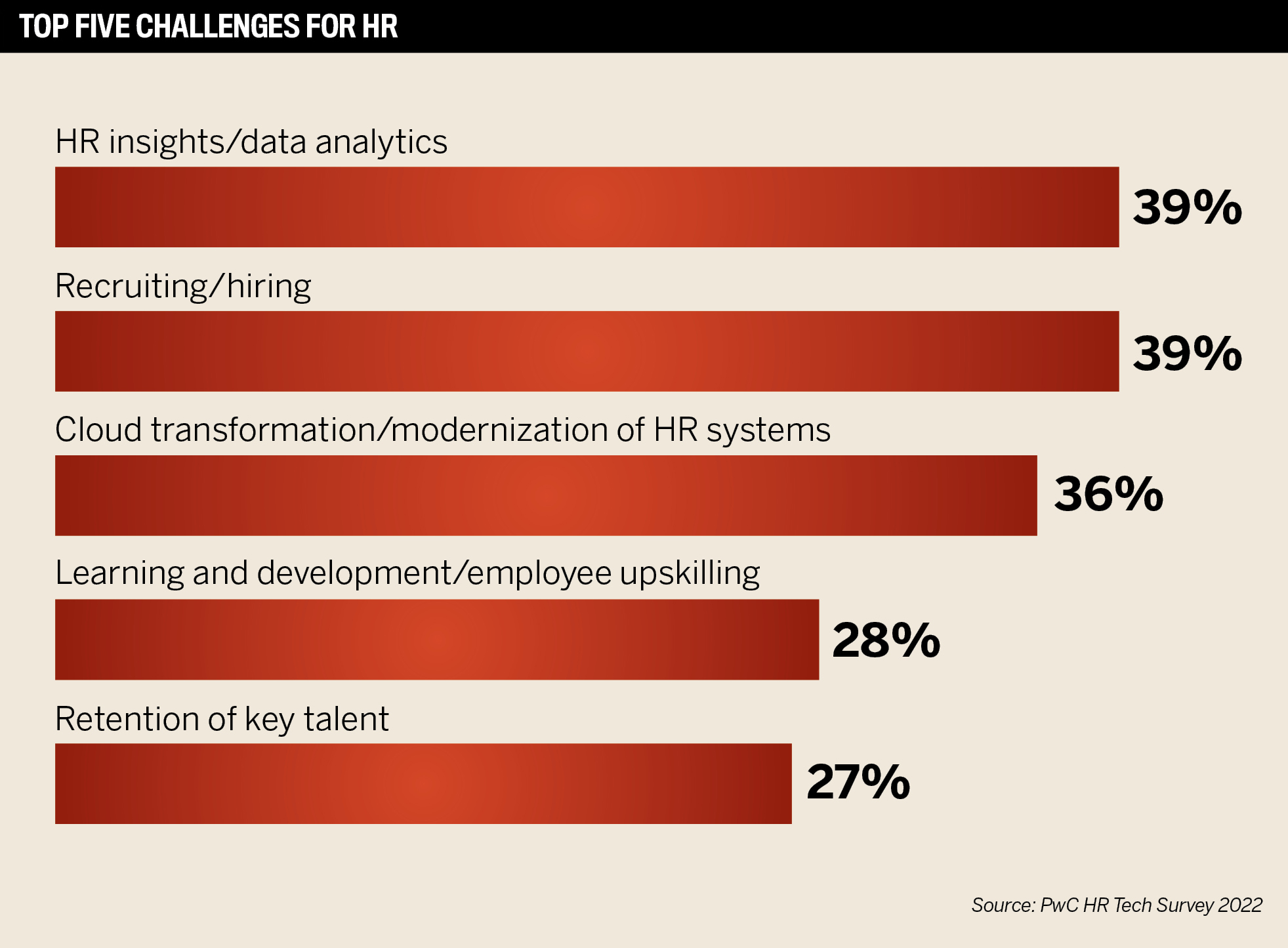

Jump to winners | Jump to methodology
Our 5-Star Software and Technology Providers 2022 are making impressive strides, and together are laying the key foundations for a tech revolution in HR.
Once that infrastructure exists, then there are widespread gains to be realized, according to Somen Mondal, general manager at Ceridian in Toronto, one of the 5-Star providers. He explains that when it comes to artificial intelligence (AI) and machine learning (ML), there is a range of untapped benefits waiting to be harnessed.
Unlike the consumer systems where these tools have been running in the background for years, AI and ML are still new territory for human resources.
“And why is that? Because a lot of the time, to run proper AI and ML models, you need all the data in one spot. And there’s very few, essentially, companies or software that have all that data in one spot,” Mondal says.
“I wouldn’t say it’s a niche. I just think we’re in the early stages of the adoption cycle of it.”
“Some leaders we talk to are focused on bringing AI into their solutions just for the sake of it. But in my opinion, this is the wrong approach”
Yuliya Sychikova, DataRoot Labs

Automation has been freeing people from uninspiring repetitive work for decades and AI/ML in HR tech is an extension of that, according to Yuliya Sychikova, co-founder and COO at DataRoot Labs in Kiev.
“I’d say that all spheres of HR are seeing the impact of AI and ML — from overall automation of HR [and] recruitment tasks to bias-free hiring. If there are still untouched niches, they will soon be disrupted by new startups and AI-driven technologies.”
Another area that can be tackled is employee development, specifically coaching and engaging employees to enable personal growth, along with culture maintenance and HR management.
But a big challenge to overcome is the lack of understanding of what AI and ML can do for an organization.
“Some leaders we talk to are focused on bringing AI into their solutions just for the sake of it. But in my opinion, this is the wrong approach,” Sychikova says. “First, businesses have to identify concrete problems and then assess all possible solutions including building AI/ML algorithms. Even if AI/ML can contribute to solving, sometimes the prohibitive cost of training might not justify the purpose. So, the overall ROI of each project has to be carefully calculated before launch.”
Mondal believes there’s a misconception that automation will replace jobs, but people are realizing that AI/ ML can make a big difference when it comes to recruitment and talent management, “enabling them to do a better, more efficient, more accurate and more fair job”.
For example, keywords in application tracking systems can identify more valuable job candidates, allowing recruiters to spend more time on one-on-one interviews with potential recruits.
“It’s not making it less human, it’s just providing the human with more time to do things that computers can’t do very well,” he adds.
The investment dollars have so far gone mostly into talent acquisition, but that’s slowly changing to include talent management. Why the disparity? Talent acquisition has straightforward metrics, according to Mondal.
“With talent management, when you bring in AI, you might be able to affect statistics or metrics like retention, but those take longer to prove out. So I think the immediate value and why people gravitated towards talent acquisition is because it’s easier to explain, it’s easier to understand.”
The data is typically more centralized, as in the case of an applicant tracking and recruiting system.
Mondal adds, “For talent management, you might have performance learning, compensation, all of these different areas that could be different data silos, where it makes it much more difficult to run models over all those silos, especially if you’re using different actual systems.”
There are two main areas in HR that are seeing the biggest impact, according to Mohamad Chakroun, vice president of product development at ADP in Toronto.
The first is operational, which involves issues like productivity. It’s about making HR more effective with tools such as chatbots.
They “continue to learn by engaging the subjects in that area, whether it’s an employee or it’s someone you’re trying to recruit, that you interface with. The chatbot can help a lot in terms of acquiring a lot of the knowledge and itself learns through all that, and then eventually, over time, it will actually provide a lot of effectiveness for practitioners.”
The second is the talent side, where AI and ML can help HR better identify and match ideal candidates. Chakroun says, “You want to get the best kind of contributors, and you want to make sure you retain them as well. So how do you identify the best talent and how do you make sure that talent does not leave you?”
It’s about understanding the person’s experience and growth, and what their future looks like with you as an employer.
The “smart” tools can also assess if certain people are flight risks.
“We can look at that individual, how much they’re making, how long they’ve been in the job, their responsibilities that have been taken over time, the level of engagement, all that tells us a lot in terms of ‘Will this person stay with us or [are they] about to leave us?’ considering also external factors.”
These newer tools also help HR’s continued growth towards a strategic role instead of a solely administrative one.
Chakroun says, “You could do a lot of these tedious tasks, in terms of posting a job or checking résumés, and all those… but is that really where you want to spend your time on, for the effectiveness of the company? We know that all these things could be done via smart tooling and augmented intelligence… with the data you collect.”
Just having data is not enough, as Chakroun explains.
“Unless you have a good way of interpreting the data, you might come to the wrong realization, so having the right thought process around that data is key.”
For example, in looking at DEI, limited data about just your company will not provide the same insights as rich data from other companies or the larger community. So a small company won’t see the same benefits – or accuracy – from a smaller data pool.
Many employers may have the data, but being able to run analytics, machine learning and AI across it is extremely difficult, says Mondal, which is why it’s so important to have the data in a central location.
“Down the road, if you start thinking, ‘Where’s AI going? Where is machine learning going?’ Again, it’s all about having the data, it’s all about being able to utilize that data. Having it all in one spot is extremely important.”
It’s also the only way to do end-to-end HR, he says, “from talent acquisition — who applied to a job, who clicked on job, who clicked on what job description — to who was promoted… who gets paid what. Having that end-to-end data, it’s very difficult if you don’t have one system.”
Having reliable, compliant data is no longer the problem it once was according to Sychikova.
“Now, the world has evolved and we see even startups come to us with pretty good and structured data sets.”
“It’s not making it less human, it’s just providing the human with more time to do things that computers can’t do very well”
Somen Mondal, Ceridian

However, vigilance is still paramount as data containing biases will result in a biased model.
Sychikova explains, “Identifying which data to analyze is another side of this problem. Is your AI analyzing CVs or written answers to questions or a video interview? Each of these might have its own bias risks and limitations.”
People themselves have bias but it’s about having trust in the new technology, according to Chakroun.
“The intelligence is there, and I think you have to have the acceptance… that it’s going to be working… it’s going to be good for my business, good for my people.”
When people express concerns about algorithms having bias, it’s about asking them: “How do you know your humans don’t have a bias? What are you doing to audit even your human?” says Mondal.
“Whether it’s a human or an algorithm doesn’t matter. Bias is calculated by looking at demographic data, looking at who was brought to different stages in the talent process. So, the actual process of measuring whether or not you’re being fair or not fair, or there’s a bias or not a bias, measuring the actual outcomes, and figuring that out, is the same whether it’s an algorithm or a human.”
That’s why it’s important to audit the algorithms, looking at the demographic data from one stage to the next, Mondal adds.
“We monitor that, measure that, to ensure that we’re not introducing adverse impacts.”
“Unless you have a good way of interpreting the data, you might come to the wrong realization, so having the right thought process around that data is key”
Mohamad Chakroun, ADP
To select the best HR software and technology providers for 2022, the Canadian HR Reporter team conducted one-on-one interviews with HR professionals and surveyed thousands more within its network to gain a keen understanding of what these professionals think about current market offerings.
Respondents were asked to rate their overall satisfaction with the HR technology providers they had dealt with across four categories: payroll solutions, HRIS solutions, reward and recognition, and recruitment software solutions.
From there, technology providers were invited to nominate their own products, describe their benefits and explain why they believed their solutions were worthy of a Canadian HR Reporter 5-Star Award. At the end of the 15-week research period, 23 companies were named 5-Star Award winners.